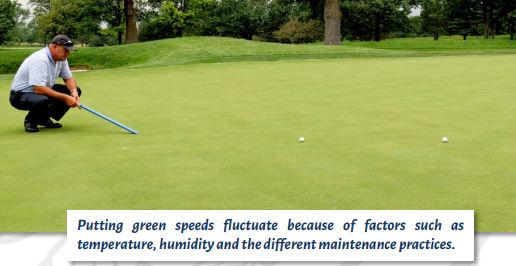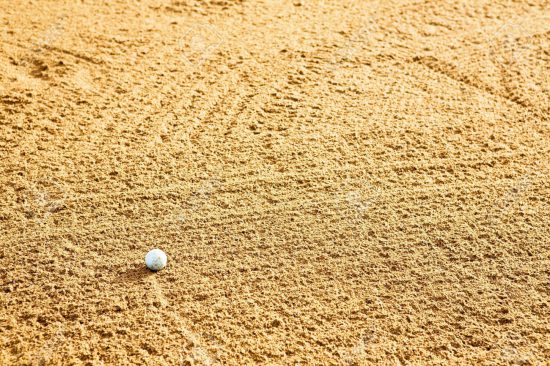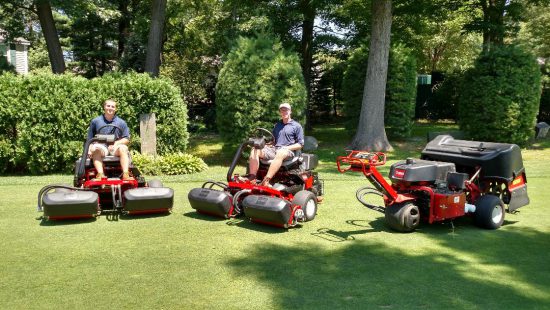2019 Irrigation Project

It’s a beautiful fall day with cool temperatures and low humidity; you are playing golf and marveling at the condition of the course, particularly the pace of the putting greens. Some golfers might be inclined to just enjoy the moment. Others will wonder why the greens can’t play like this all the time. There are a myriad of variables that affect turfgrass growth and putting green speed; and, what is possible to achieve at one time of year under certain conditions may be impossible at other times. Check out the full article .. greens_speeds

Despite the best efforts of any agronomic team, maintaining perfectly
consistent playing conditions in every bunker is not possible.
Although golf course maintenance teams may spend more labor hours attending to bunkers than greens, golfers will
still find that bunkers are inconsistent. Maintaining totally consistent playing conditions in bunkers is not achievable,
nor is it necessarily desirable. Here are five reasons why the playing conditions in bunkers will never be perfectly
consistent:
1. Sand depth – The depth of sand on the bunker floor has a profound impact on playability. If the sand is too
shallow, bunkers may be wet and firm. However, too much sand yields soft conditions that increase the probability of
buried lies. Inconsistencies in bunker sand depth develop on a daily basis from events such as normal play, raking
and wind exposure. The recommended depth for bunker sand is 4-6 inches but varies depending on factors such as
the physical characteristics of the sand and the properties of the underlying material.
2. Sun exposure – Bunkers that receive more sunlight will dry faster and play softer than those that receive less
sunlight. For example, east- and southeast-facing bunkers dry faster in the morning than bunkers oriented to the west
or the north, causing them to play softer.
3. Wind exposure – Bunkers facing the predominant wind direction will dry faster and play softer than bunkers that
are shielded from the wind or face the opposite direction.
4. Play volume – Bunkers that receive more play will be softer and less consistent than bunkers with very little
play. Why? Golf shots, foot traffic and raking disturb bunker sand and soften conditions.
5. Irrigation – Many golfers wonder if irrigation systems can be designed to avoid adding water to bunkers.
Unfortunately, such a design is impractical due to the shape and strategic location of many bunkers. Uniformly
irrigating irregularly shaped playing surfaces such as greens, green surrounds and even fairways often places
adjacent bunkers in the line of fire of sprinklers. If bunker sand is shallow, contains fine materials such as fine sand,
silt and clay, or has been contaminated with organic matter, bunkers will retain moisture. Wet sand plays firmer than
dry sand, so bunkers that receive more irrigation and retain more moisture will likely play firmer than those that are
well drained and out of the way of irrigation. CLICK FOR FULL ARTICLE: Five Reasons Why Bunkers Are Not Consistent
Replace your divots.
Turf tends to explode on impact, making it difficult, if not impossible, to replace the divot. In this case, you have two options:
You can use the toe of your shoe to kick in the turf around the edges of the divot.
Use the soil/seed mixture on your carts and tees to fill in the divot.
Rake Sand Traps — remembering that you should always enter the bunker from the low side at a point nearest to the ball.
Whenever possible, avoid walking on the steep face of a bunker.
After hitting your shot, rake the area you played from, as well as all your footprints and any others within reach.
Rakes should be left nearby the bunker.
Important to repair any pitch marks or indentations caused by the ball hitting the green.
Using a tee, knife, key or repair tool, repair the mark by working the edges towards the center, without lifting the center of the mark. Don’t tear the grass. Finish by smoothing the area with a club or your foot. Try to get the area smooth enough to putt over.
Just remember that while the Rules of Golf allow you to repair pitch marks on your putting line, you cannot repair spike marks on your putting line until after you have putted.

Have a question about course etiquette? Click This Link: http://www.pga.com/golf-instruction/instruction-feature/fundamentals/golf-etiquette